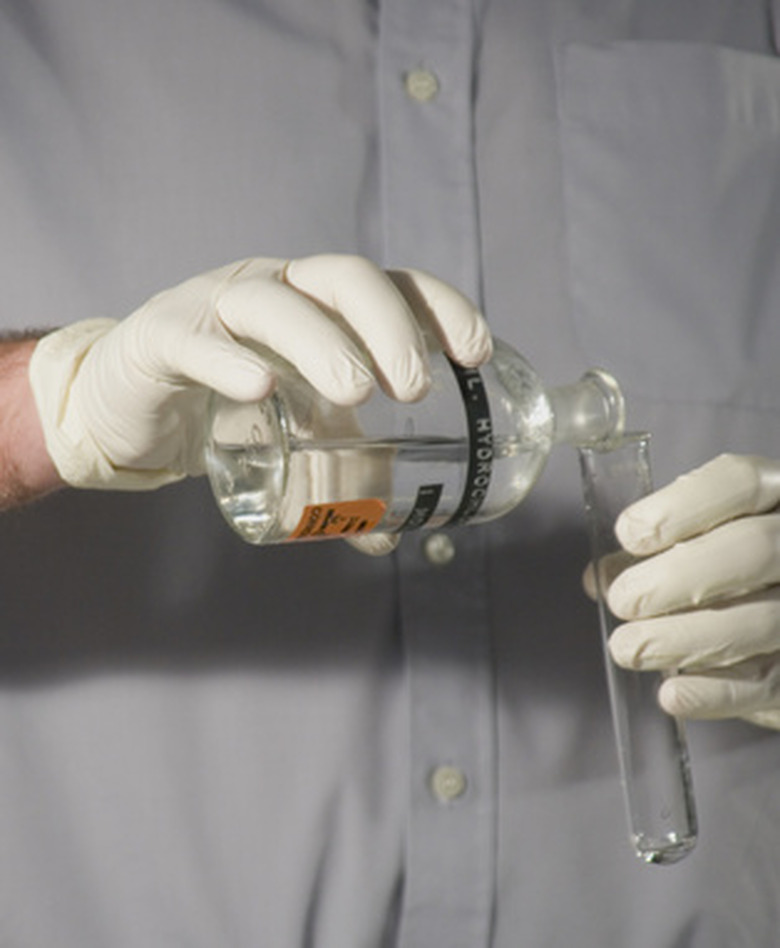Potassium Permanganate Experiments
Potassium permanganate is a strong oxidizing agent. The standard industrial use of this compound is in water treatment for color removal, taste and odor control, and removal of iron and manganese. Potassium permanganate also inactivates certain viruses and bacterias. When combined with organic materials the reaction is explosive and leaves behind a permanganate residue.
Oxidation of Glycerin by Potassium Permanganate
Oxidation of Glycerin by Potassium Permanganate
This experiment demonstrates an exothermic release of energy in the form of heat from the ensuing reaction. The reaction involves the oxidation of glycerin by potassium permanganate. Glycerin is an organic compound and an easily oxidized substance.
You need about 20 grams of potassium permanganate powder, 3 to 5 milliliters of glycerin and a pipette. You also need a clean 70 milliliter beaker, glass tamping rod or test tube, and protective eye glasses.
In a well ventilated area, scoop the potassium permanganate into the beaker. Create an impression by tamping the substance with test tube or glass rod.
Using the pipette, quickly but carefully drop glycerin into the impression. As the glycerin is oxidized, it produces a bright flame as result of an exothermic reaction.
Potassium Permanganate Diffusion in Water
Potassium Permanganate Diffusion in Water
This experiment demonstrates the principle of chemical diffusion using potassium permanganate in water.
You need a a clean 70 milliliter beaker and a few potassium permanganate crystals.
Place the crystals at the bottom of the beaker. Steadily add distilled water to the beaker up to 35 milliliters or so of volume. Because of the random movement of potassium permanganate particles, a dense purple solution forms in water at base of the beaker. The purple solution will slowly spread into the rest of the water throughout the beaker creating a less dense but evenly colored purple solution.
Making Potassium Permanganate
Making Potassium Permanganate
The synthesis of this compound is comprised of a few steps that demonstrate "redox" or reduction-oxidation reactions.
You need 7 grams of potassium nitrate, 1 gram of manganese dioxide, 2 grams of potassium hydroxide and a few milliliters of sodium bicarbonate.
Protective eye wear, a small glass vial, a 50 mililiter beaker, a small hammer, mortar and pestle and a ventilation hood are recommended.
Start the experiment outdoors or under a ventilated fume hood. Mix 7 grams of potassium nitrate and 1 gram of manganese dioxide in the vial. Using a torch, heat the vial gradually until the two chemicals melt together. Keep heat on the molten mixture for several minutes.
Add 2 grams of potassium hydroxide to the mixture and promptly re-heat the vial until a green boiling substance appears. Continue boiling mixture for 5 to 7 minutes. Take the torch off the boil and let the vial cool down.
After the mixture is a green solid, use the hammer to smash the substance into smaller pieces. Use the mortar and pestle to grind the pieces to a powder. Pour the powder into the beaker and dissolve in 50 mililiters of distilled water.
After the solution turns green, pour off the mixture that has risen to to top. Add the sodium bicarbonate in small increments while stirring steadily until the solution takes on a purple color. Adding too much sodium bicarbonate will result in a light pink color that signifies a destruction of permanganate.
References
Cite This Article
MLA
Badger, Matthew. "Potassium Permanganate Experiments" sciencing.com, https://www.sciencing.com/potassium-permanganate-experiments-12393210/. 6 October 2017.
APA
Badger, Matthew. (2017, October 6). Potassium Permanganate Experiments. sciencing.com. Retrieved from https://www.sciencing.com/potassium-permanganate-experiments-12393210/
Chicago
Badger, Matthew. Potassium Permanganate Experiments last modified March 24, 2022. https://www.sciencing.com/potassium-permanganate-experiments-12393210/
